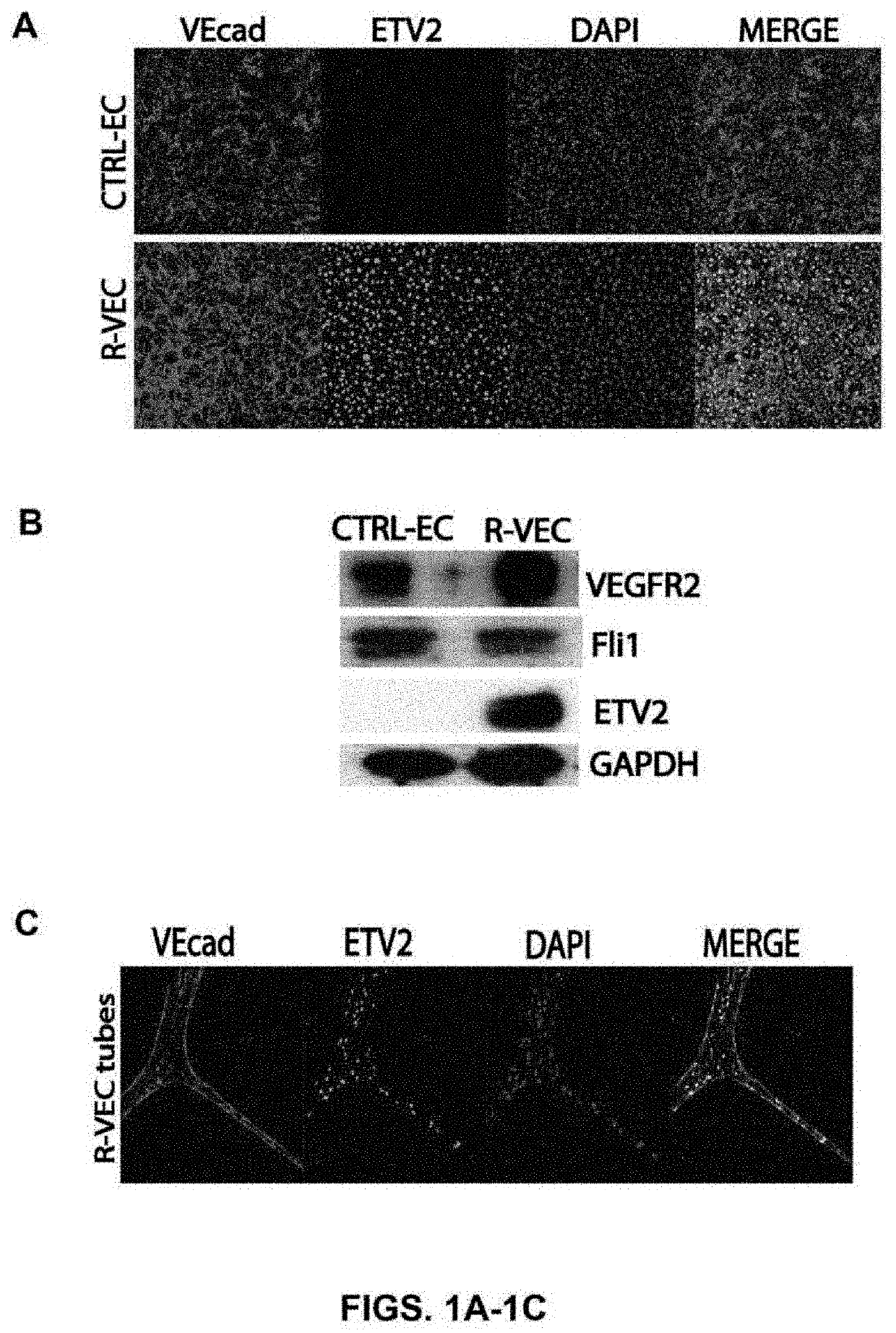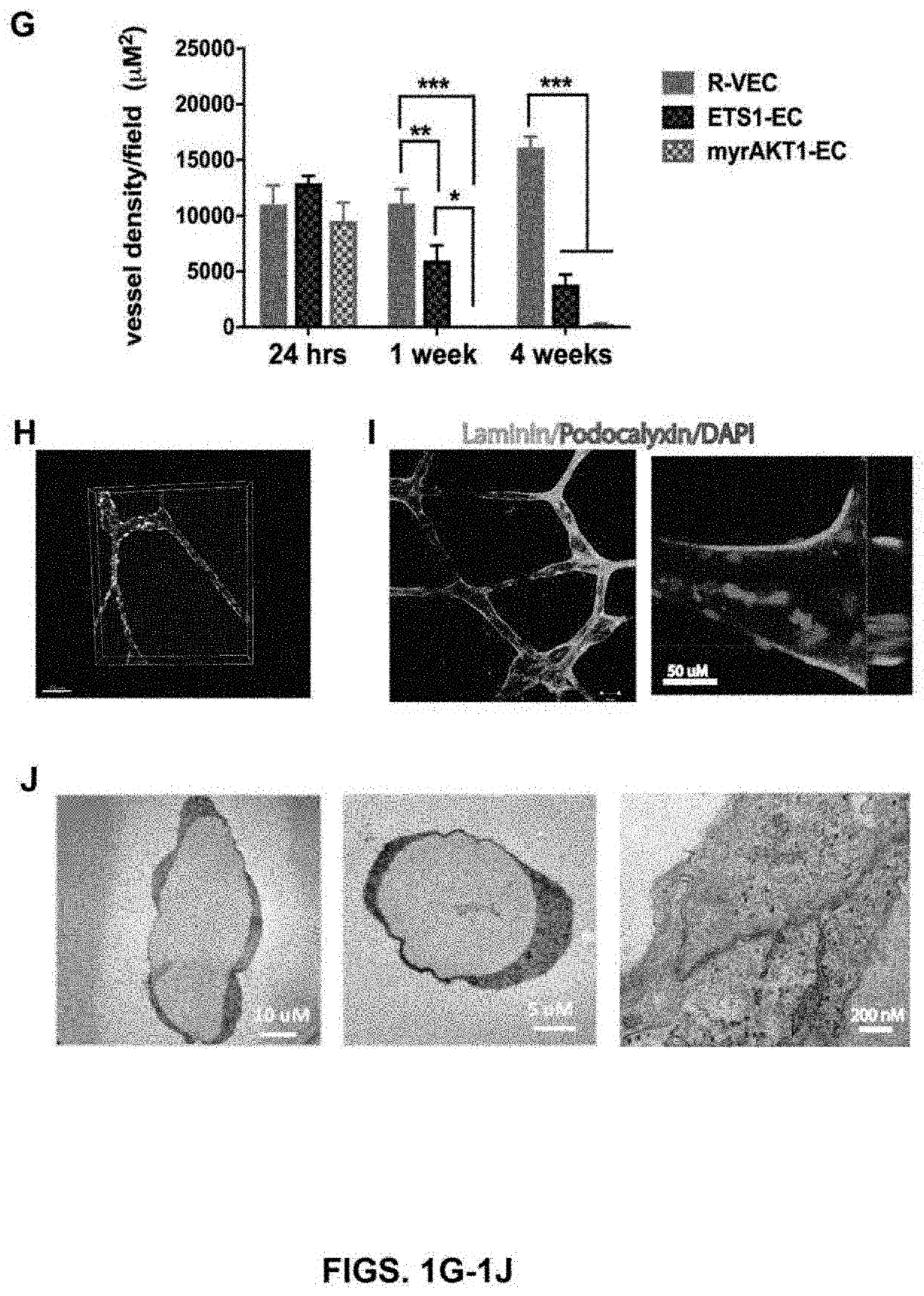Stable three-dimensional blood vessels and methods for forming the same
a three-dimensional, stable technology, applied in the direction of artificial cells, genetically modified cells, prosthesis, etc., can solve the problems of limiting the remodeling and patterning of putative capillary networks in culture, cumbersome and time-consuming approaches to generate stable blood vessels in vitro for translation to clinical settings, and ineffective long-term use of functional durable capillaries
- Summary
- Abstract
- Description
- Claims
- Application Information
AI Technical Summary
Benefits of technology
Problems solved by technology
Method used
Image
Examples
example 1
and Methods
[0121]Cell culture. Human umbilical vein endothelial cells (HUVEC) and human adipose tissue endothelial cells were isolated in lab using a collagenase-based digestion approach as set forth in Ginsberg, M. et al. Cell (2012) 151, 559-575, the entire contents of which is incorporated herein by reference. The isolated endothelial cells were then grown in tissue culture dishes coated with 0.2% gelatin grown in complete media (400 ml of M199, 100 ml heat inactivated FBS, 7.5 ml Hepes, 5 ml antibiotics, 5 ml glutamax, 5 ml of lipid mixture, and ½ bottle of endothelial cell growth supplement (Alpha Aesar). The cells were transduced with lenti pgk-ETV2 or an empty lentivector after passage. As necessary, the cells were also labeled by using pgk-mCherry or pgk-GFP lentivirus. The cells were split 1:2 using accutase and passaged on gelatinized plates. As necessary, cells were frozen down to be used in future experiments. Overall, more than 10 batches of different HUVECs were used f...
example 2
Expression of Exogenous ETV2 in Endothelial Cells Forms Long-Lasting and Stable Three-Dimensional Artificial Blood Vessels In Vitro
[0152]The present studies show that transient induction of ETV2 in differentiated endothelial cells will reprogram endothelial cells to acquire enhanced cellular affinity for non-vascular cells as well as develop durability and patterning plasticity to form stable, three dimensional artificial vessels in vitro and in vivo. To determine whether ETV2 transcription factor expression altered vessel formation, endothelial cells transduced with ETV2 were single cell FACS sorted and clonally grown out. Exogenous ETV2 expression in endothelial cells consistently resulted in the formation of branched sprouting vascular networks with organized durable geometric patterns of artificial blood vessels that often localized to the surface of the extracellular matrix.
[0153]Dosing of ETV2 by a lentivirus vector was assessed in both flat endothelial cells forming typical p...
example 3
al Cells Expressing Exogenous ETV2 Form Stable, Three-Dimensional, Functional Vessels In Vivo
[0158]The potential of endothelial cells expressing exogenous ETV2 to sustain functional patterned vessels was assessed using in vivo murine models. Here, SCID-beige mice were implanted subcutaneously with plugs containing mCherry or GFP labeled control human endothelial cells or reprogrammed endothelial cells expressing exogenous ETV2 mixed with laminin, entactin and collagen IV (L.E.C.). One to five months post implantation, the degree of vascularization (vessel persistence and anastomosis to the pre-existing murine vasculature) was assessed by intravital staining as shown in FIGS. 3A-M. FIG. 3A shows that mice administered plugs having reprogrammed endothelial cells expressing exogenous ETV2 (R-VEC) were visibly more vascularized than those administered control non-ETV2 transduced control endothelial cells. Both whole mount confocal pictures, as well as post sectioning of the plugs, revea...
PUM
 Login to View More
Login to View More Abstract
Description
Claims
Application Information
 Login to View More
Login to View More - R&D
- Intellectual Property
- Life Sciences
- Materials
- Tech Scout
- Unparalleled Data Quality
- Higher Quality Content
- 60% Fewer Hallucinations
Browse by: Latest US Patents, China's latest patents, Technical Efficacy Thesaurus, Application Domain, Technology Topic, Popular Technical Reports.
© 2025 PatSnap. All rights reserved.Legal|Privacy policy|Modern Slavery Act Transparency Statement|Sitemap|About US| Contact US: help@patsnap.com



